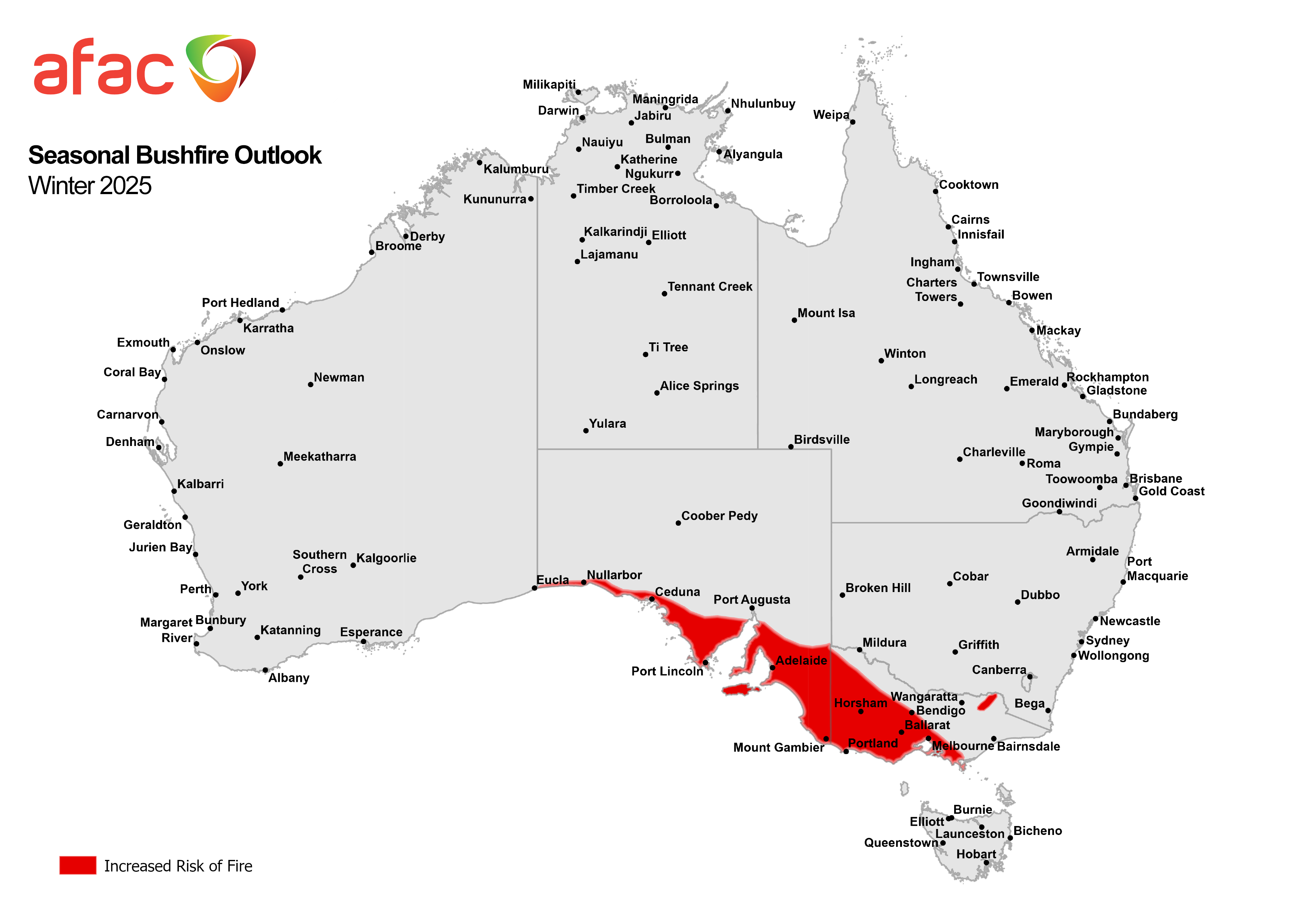Seasonal Bushfire Outlook Winter 2025
The Seasonal Bushfire Outlook for winter 2025 identifies a heightened risk of fire for parts of SA and Victoria. The unseasonable bushfire risk potential for these southern regions is driven in part by significant and persistent dry conditions.
The Seasonal Bushfire Outlook for winter 2025 identifies a heightened risk of fire for southern coastal areas of SA and significant portions of western, southwestern and southeastern Victoria.
The unseasonable bushfire risk potential for these southern regions is driven in part by significant and persistent dry conditions. There is an abundance of dry material in both grass and forest vegetation in Victoria, and southern scrub and forest areas of SA. However, drought conditions have reduced fire risk in pasture and crop landscapes.

AFAC CEO Rob Webb said: "We don't normally think of winter and bushfire together in southern Australia. The prolonged drought conditions mean that communities across parts of Victoria and South Australia may see more activity than normal for this time of the year."
"Fire authorities will monitor the landscape conditions and climate influences closely this season to manage bushfire risk and identify opportunities for mitigation activities such as planned burning.”
Long-term rainfall deficiencies persist in southern SA, Victoria and Tasmania. In contrast, tropical activity has continued into May, beyond the typical end of the northern wet season, with above average rainfall in parts of the north, and along the east coast.
Higher than average pressure over the south has been contributing to drier conditions across southern Australia, consistent with longerterm trends attributable to climate change. Warmer than average sea surface temperatures persist around much of the Australian coastline, providing increased moisture and energy that can enhance the severity of storms and weather systems.
June to August is very likely to be warmer than average nationwide, with above average rainfall across much of the Australian mainland, except in the southeast and southwest. The El Niño–Southern Oscillation is forecast to remain neutral, while the Indian Ocean Dipole is expected to tend negative over the coming months.
Communities are encouraged to be vigilant and stay alert this winter, even in areas of Australia that show a normal risk of fire this season.
The Seasonal Bushfire Outlook combines expert analysis of bushfire fuels, past rainfall and temperature, and climate outlooks prepared by the Bureau of Meteorology.
This Seasonal Outlook was developed by AFAC, the Bureau of Meteorology, Queensland Fire Department, NSW Rural Fire Service, ACT Emergency Services Agency, ACT Parks and Conservation Service, Country Fire Authority, Department of Energy, Environment and Climate Action VIC, Tasmania Fire Service, SA Country Fire Service, Department of Fire and Emergency Services, Department of Biodiversity, Conservation and Attractions WA, and Bushfires NT.
Attachments:
ACT_Seasonal-Bushfire-Outlook-Winter-2025.png
AFAC-Seasonal-Bushfire-Outlook_Winter-2025_v1.0.pdf
AUS_Seasonal-Bushfire-Outlook-Winter-2025.png
NSW_Seasonal-Bushfire-Outlook-Winter-2025.png
NT_Seasonal-Bushfire-Outlook-Winter-2025.png
QLD_Seasonal-Bushfire-Outlook-Winter-2025.png
SA_Seasonal-Bushfire-Outlook-Winter-2025.png
TAS_Seasonal-Bushfire-Outlook-Winter-2025.png
VIC_Seasonal-Bushfire-Outlook-Winter-2025.png
WA_Seasonal-Bushfire-Outlook-Winter-2025.png